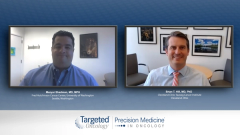
An Introduction to DLBCL: Current Approaches and Challenges
Mazyar Shadman, MD, MPH, and Brian T. Hill, MD, PhD, explain the intricacies of the diffuse large B-cell lymphoma treatment landscape.
Episodes in this series

Mazyar Shadman, MD, MPH: Hello, and thank you for joining this Targeted Oncology presentation titled “The Role of CD19 in the Targeted Treatment of Relapsed/Refractory Diffuse Large B-Cell Lymphoma.” Transplant-ineligible patients with diffuse large B-cell lymphoma have relatively limited treatment options, and that usually leads to poor clinical outcomes. CD19 has recently emerged as a promising therapeutic target for patients with relapsed or refractory disease, and both CAR [chimeric antigen receptor] T cells and monoclonal antibodies directed to CD19 have shown clinical efficacy in clinical trials and now in practice. In today’s presentation, we talk about the role of CD19 as a target for treatment of patients with relapsed/refractory diffuse large B-cell lymphoma.
I’m Dr Mazyar Shadman, an associate professor of medical oncology at the University of Washington and Fred Hutchinson [Cancer Research Center] in Seattle, Washington. Joining me is my colleague Dr Brian Hill, the director of the lymphoid malignancies program at the Cleveland Clinic Taussig Cancer Institute in Ohio. Dr Hill, thanks for joining me. Let’s start with getting some background on diffuse large B-cell lymphoma. Maybe our colleague can tell us a little about how big of a problem diffuse large B-cell lymphoma is, and then we’ll get started on treatment approaches.
Brian T. Hill, MD, PhD: Yes, Mazyar. It’s good to see you. Non-Hodgkin lymphoma is many different diseases, but diffuse large B-cell lymphoma is the most common form of lymphoma, the most common form of aggressive lymphoma. There’s probably somewhere around 30,000 new cases diagnosed each year, and there are some differences among patients with diffuse large B-cell lymphoma.
Not all cases are the same. We know that some patients have a diffuse large B-cell lymphoma derived from a germinal center B cell, and others have a disease that’s derived from what’s called an activated B cell, a more mature B cell. The way we differentiate these clinically in common routine practice is with standard immunohistochemistry staining that’s done on the biopsies. We really can’t say precisely that it’s activated B cell or germinal center [GC]. We say it’s GC or non-GC subtype, and those with the non-GC subtype, which encompasses activated B cell subtype and others, tend to have slightly worse prognosis. But in 2021, we’re still treating them all the same way, which is basically with R-CHOP [rituximab, cyclophosphamide, hydroxydaunorubicin hydrochloride, vincristine, prednisone] chemotherapy, and I suspect that’s your approach in the vast majority of cases as well, Mazyar.
Mazyar Shadman, MD, MPH: Yes, that was my question: Would the cell of origin change your treatment approach? You answered that question. What are the molecular or cytogenetic markers that would have an impact on your treatment of choice for large cell lymphoma at the Cleveland Clinic?
Brian T. Hill, MD, PhD: What we and most other large centers are doing is we’re changing away from R-CHOP [rituximab, cyclophosphamide, hydroxydaunorubicin hydrochloride, vincristine, prednisone] only when we know that we have so-called double-hit lymphoma.
Mazyar Shadman, MD, MPH: Yes, exactly. The only marker outside clinical trials that would change our treatment approach from R-CHOP [rituximab, cyclophosphamide, hydroxydaunorubicin hydrochloride, vincristine, prednisone] is, as you mentioned, having patients with MYC rearrangement and/or BCL2 and BCL6. We use dose-adjusted R-EPOCH [rituximab, etoposide, prednisone, vincristine, cyclophosphamide, hydroxydaunorubicin hydrochloride] mainly based on nonrandomized trials. But it sounds like that would be a patient population, that you want to do your best up front, and some prospective studies have shown that more intensive treatments are helpful in that setting. It’s great to see a large percentage of patients with large cell lymphoma being cured with the first-line therapy, and 60% to 70%, depending on which data set we look at and what study we look at. But we all, unfortunately, know that there will be patients who will have relapse early or may have even primary refractory disease to the first-line therapy, and then some who will relapse later. That’s an unmet need.
This transcript has been edited for clarity.








































